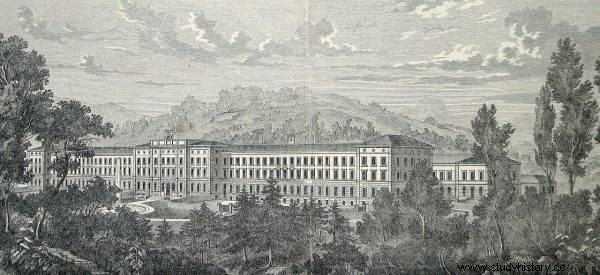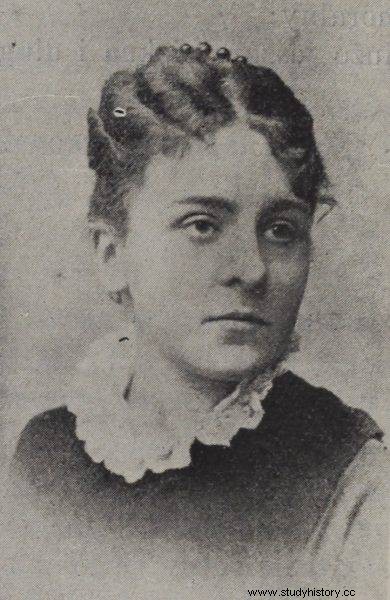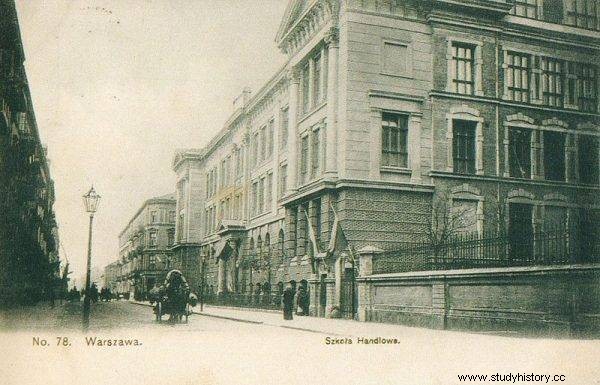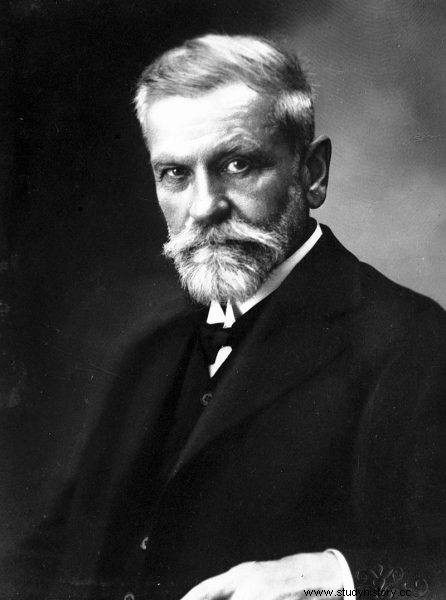They were called contemptuously "medicine men", their knowledge was mocked, their morals and competences were undermined. Even those whose skills surpassed their colleagues had no chance of practicing medicine, not being able to obtain the necessary permits or chances to gain the patients' trust. What was the path of women to the medical profession in the 19th century?
The first certified doctor practicing in Poland was born in 1854 in Mława as the daughter of a Russian military police colonel Władysław Tomaszewicz and Jadwiga née Kołaczkowska, descending from a landed gentry family. The circumstances of her birth already predicted her strength of character and a turbulent life - the birth took place during a raging storm of thunder and lightning. In 1869, Anna graduated from Mrs. Paszkiewicz's higher salary, but she did not intend to confine herself to education appropriate for well-born virgins of her time. As we read in the novel Students of Hippocrates. Dr. Anna by Albena Grabowska:
"When she finished her salary with honors and told her parents about her wishes, my father started laughing. The mother did not speak to her for two days. Then they said they might consider sending her to study medicine if Anna were born a boy . [...] They appealed to her sense, advised her to become a teacher, since she wanted to be educated so much. "
However, Anna was not going to be a teacher. She wanted to become a doctor, although in her time no university in Poland allowed women to study medicine . Also, the parents did not accept their daughter's plans - both for moral reasons (studying at that time was considered almost as unworthy of a woman as prostitution) and economic reasons, because the family was large and not very wealthy. Anna was stubborn enough to go as far as starving to force her father to accept studies abroad and help finance them . For two years she was tutoring in biology, physics, chemistry, French, German and Latin to be able to take the exams. When she was leaving the country, the Warsaw press wrote:
"In September 1871, Anna Tomaszewiczówna left Warsaw for Zurich to study medicine at the university there."

In the last year of studies, Anna Tomaszewicz received the position of an assistant in Burghölzli with prof. Edward Nidzic, a recognized neurologist and psychiatrist
Just four years earlier, in 1867, when Joseph Lister in The Lancet described the antiseptic properties of phenol, opening a new era in the history of surgery and medical science, the University of Zurich admitted students to the Faculty of Medicine. Before a Polish woman, six Russian, four German, two English and one American were educated at this faculty. In the last year of studies, Anna Tomaszewicz received the position of an assistant with prof. Edward Nidzic, a recognized neurologist and psychiatrist. In 1877, under the supervision of prof. Ludimara Herman wrote her diploma thesis "Contribution to the physiology of the auditory labyrinth", passed her final exams and left Zurich with her medical diploma in a briefcase. Although she was offered to go to Japan, she wanted to return to her country and start an internship there.
The imaginary goals of a certain adventurer
Anna Tomaszewicz was 23 years old, completed her studies and admired scientific achievements, when she stood in front of the noble group of the Warsaw Medical Society with the intention of taking up medical practice in the country. At a meeting on January 8, 1878, her candidacy was rejected by secret ballot :19 members voted in favor of the admission against eleven, and the Society's statute stated that a two-thirds majority was required. In Medical Review this was summed up by the words:
"It is regrettable to admit that Miss Tomaszewicz, at the very beginning, only experiences unpleasantness in her profession. She wanted to take an exam here and went to the curator of the scientific district, who sent her to the minister, and the minister refused to do so. She also offered her services to the Red Cross Society, but that turned her down. ”

Doctor Gustaw Fritsche claimed that male doctors were doing very well. They didn't need the help of a woman.
In many circles, the mere fact that a woman had dared to study medicine and wanted to practice medicine was a sign of degeneration. Doctor and publisher of Medycyna Gustaw Fritsche commented on the situation in 1878:
"Having carefully examined the case of female doctors, we come to the conclusion that it does not correspond to any pressing need, since male doctors are perfectly suited to the purpose. Second, that studying medicine and practicing medicine is highly inappropriate for the disposition, aptitude, and character of women. Third, that, with a small exception, all of today's doctors or candidates for such are pushed onto this false path, not by a love of science or a willingness to devote themselves to humanity, but by some adventurous disposition, by a desire to shine with something original. Finally, fourthly, that the range of women's activities in the family is so lofty and so extensive that it should not be distracted from it and encouraged to pursue some imaginary goal which they will never be able to achieve. "
Progressive Oman and fossilized Warsaw
The newly minted doctor decided to go to Saint Petersburg to obtain the recognition of her diploma there, but at that time a tsarist decree was issued, according to which Russian subjects were forbidden to study medicine in Zurich. She would have returned with nothing, but fate would have hosted the Sultan of Omam with a harem, who was looking for a slave or a woman doctor who spoke Western languages fluently. Anna got a job and thanks to this she had the opportunity to practice her profession, and at the same time get to know a different culture and its customs, and at the same time obtained the recognition of her diploma . The Medical Society had no choice then and had to accept the diploma of doctor Tomaszewicz, and an additional slap for the fossilized group were the comments of the Russian press, which on the one hand accused Poles of backwardness and conservatism, and on the other hand wrote how the Warsaw doctors fortunately "saved the lady from herself ”.

Portrait of Anna Tomaszewicz-Dobrska
After several months in Russia, Dr. Tomaszewicz was able to return to Warsaw and start her medical practice. In June 1880, she opened an office in Warsaw. Warsaw newspapers reported:"Our first female doctor, Mr. Tomaszewicz, at the clinic on Niecała Street, provides medical advice in the case of diseases of women and children during designated hours," but patients did not stand in long lines, because social trust in the female doctor was very low . The wedding with the ENT specialist Konrad Dobrski, who was mentioned in Nowiny , contributed to the improvement of this situation. on August 11, 1881 under the heading Doctor and Doctoral :
"An interesting wedding took place in Warsaw in July. Dr. Konrad Dobrski married a doctor, Miss Anna Tomaszewicz, who had done an examination and has a patent for a doctor; after the wedding, the bride and groom went to a doctors convention in Krakow. ”
Vows of chastity as a rescue for obstetricians
Another breakthrough in the life and practice of Anna Tomaszewicz-Dobrska was the endemic of puerperal infections, which broke out in the Warsaw maternity clinic. The then fatal disease forced the authorities to close the facility and suspend admitting patients, which for a city with a population of half a million, where approximately 14,000 children were born each year. women, was unthinkable. A specially appointed committee chaired by the mayor of the city applied for the creation of five maternity shelters, for which one of the capital's richest entrepreneurs and philanthropists, the banker Leopold Stanisław Kronenberg, donated a huge amount.
In the fall of 1882, the shelters were opened, and thanks to the intercession of Konrad Dobrski, as well as intellectuals of that time, such as Bolesław Prus, Aleksander Świętochowski, Eliza Orzeszkowa and Maria Konopnicka, the founder entrusted the management of the shelter at ul. Prosta, doctor Tomaszewicz-Dobrska. The Warsaw tenement house handed over by Kronenberg to an asylum can hardly be called an ideal place to run a maternity clinic . In the Report on the activities of the 2nd Maternity Home announced after its liquidation in 1911, Dr. Tomaszewicz-Dobrska wrote:
"For the first few years, Asylum 2 occupied an apartment in an old house, consisting of four rooms with such a layout that none of them could be excluded from the whole. The dramatization of this audience consisted of:a sink without a water supply; bringing water in buckets and pouring it into a barrel from which it was taken for all uses; no toilet, which was replaced with buckets of Otwock powder; ventilation with barrels that I open, immediately closed behind my back, stoves fired with coal, cracked with age, incurably smoking; lighting with kerosene lamps; hand wash in a tub, without cooking linen. The kitchen was a kind of Pantheon, encompassing all cults and all rites. It was used to prepare food, as a place for a water tank, as a pantry, bedrooms for two servants, a changing room for patients' things and clothes, old and wasteland storage room, dirt store, laundry, drying room, washroom, admission room, undressing, examining, bathing newcomers and children, dining room, waiting room, playroom for visitors and members of the household ”.
In 1883, in the shelter at ul. Prosta, 96 children were born, each year there were more of them, until 420 in 1910, when for two decades it was located at ul. Żelazna 55, in better housing and sanitary conditions, with twice the area, water supply, toilets, isolation rooms and a separate laundry room. Every year, over half a thousand mothers, mainly from the poorest strata (single women, maidservants, seamstresses, wives of craftsmen and workers) received professional medical assistance and loving care here. In 1896, doctor Tomaszewicz-Dobrska was the first in Warsaw to perform a caesarean section in his clinic . She was also a pioneer in the field of antiseptics, reducing the mortality of patients to 1%, which was a phenomenon on a global scale, arousing the interest of the medical community in Poland and abroad. It is worth mentioning the hygiene rules introduced by her, because after a hundred years they still remain valid.

In 1883 the orphanage was located on Prosta Street in Warsaw
"A vow of chastity sanctify your profession.
Have no beliefs other than bacteria, no aspirations other than decontamination, no ideal other than sterility.
Swear to the spirit of the time not to blaspheme it in any way, especially hard and empty raving about colds, overeating, fear, agitation, hitting food on the brain, or whatever else a heresy that denies the contagious nature of fever.
Curse for eternal damnation oil, sponge, eraser, grease, and anything that hates or knows fire because it is bacterial.
Near pregnant, in labor, obstetricians, eyes and navels of babies, always be aware that the invisible enemy is lurking everywhere, on them, on you, around you and in yourself.
Do not touch them, even with the scream and groan of your help, until you put on white from head to toe, your naked hands and arms, as well as their bodies, You will not anoint with plenty of soap, perhaps you will not mix them with two hot waters and two liquids of great bactericidal power.
The first self-examination is ordered to you, the second is admissible, the third must be excused, the fourth can be forgiven, the fifth will be charged to you as an offense.
Let slow heart rate and low warmth be your highest honor. "
Asylum at ul. Prosta, and later Żelazna, also served as a training center for obstetricians, midwives and auxiliary staff. "You will be immersed in poverty and filth" - she addressed her students until this statement became part of her legend. - "You can do nothing for poverty, but for dirt you can do." After three decades of hard work, when in 1911 shelters in Warsaw were closed and two maternity hospitals were established in their place (one at Żelazna Street, the other at Karowa Street), Dr. Tomaszewicz-Dobrska refused to take over the management.

together with Maria Konopnicka and Eliza Orzeszkowa, she organized the 1st Congress of Polish Women in 1907.
However, she did not stop admitting patients, and at the same time conducted social activities, using the authority, recognition and respect that she had gained after many years of work . She was involved in the activities of the Charity Society and the Society of Summer Camps for Children, she was a co-founder of the Polish Culture Society, together with Maria Konopnicka and Eliza Orzeszkowa led to the organization of the 1st Congress of Polish Women in 1907, she wrote articles on medical and social issues. She died in 1918 of tuberculosis, which she probably contracted much earlier than one of the patients. Friends, knowing her views, organized a fundraiser instead of flowers for the "A Drop of Milk" campaign supported by her for the treatment and nutrition of infants from the poorest districts of Warsaw . This is another proof of how far the first Polish doctor was ahead of her time.
The woman comes to the doctor and the doctor ... a freak
Currently, the profession of a doctor in Poland is practiced by - according to the data of the Supreme Medical Chamber - over 92.5 thousand. women, which is almost 60% of the total. In the 90s of the twentieth century in social magazines it was written that women performing newly opened professions to them are more closely watched than men, so one slight error is enough for critics to prove that "medicine is not appropriate for women, that they take they do things they can't cope with. ”
It was also difficult to refute accusations from authorities, such as Professor Ludwik Rydygier, who ridiculed equality and thundered in Przegląd Lekarski from 1895:"Away from Poland with the freak of a female doctor!" The distinguished surgeon was convinced that, being both physically and mentally weaker, women were not even fit to be obstetricians, because they lacked the skills necessary to give birth ticks .

Odo Bujwid defended women doctors and their rights to practice
Few doctors defended the fair sex in their profession - among them it is worth mentioning prof. Odo Bujwid, the first Polish bacteriologist, promoter of hygiene and health prophylaxis and in the field of therapeutic vaccine production, as well as Dr. Napoleon Cybulski, a three-time Nobel Prize-nominated physiologist, co-discoverer of adrenaline, one of the founders of endocrinology, a co-discoverer of brain currents and a pioneer of electroencephalography. N but if they were among the narrow group of people who viewed the pioneers in the profession with appreciation and admiration, most nevertheless held a grudge against women for undermining the centuries-old order of things, demanding rights that do not belong to them because of their gender . 150 years later, when the problems faced by "medical women" and emancipated women seem to echo the past, unfortunately the opinions repeatedly expressed by Anna Tomaszewicz-Dobrska herself about how much it costs women to fight for their rights and how much work requires such a fight.
The article was inspired by the novel “Doktor Anna. Students of Hippocrates ”by Albena Grabowska, publ. 2021 margins
